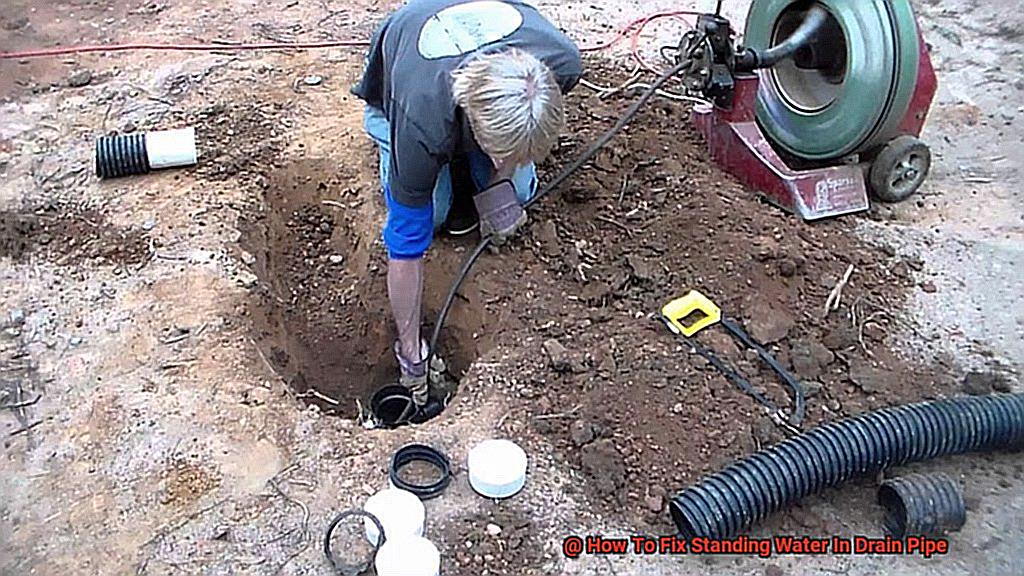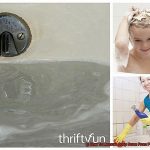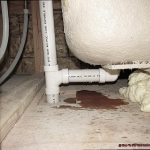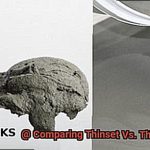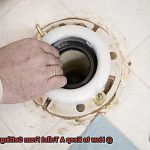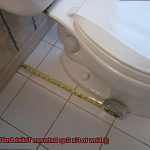Do you dread the sight of standing water in your drain pipes?
Are foul smells and slow drainage causing headaches? Fear not.
I have discovered some fascinating ways to eliminate this issue once and for all. Blockages in your pipe are often the root cause of stagnant water.
Accumulation of smog, grease, soap scum, and food waste over time leads to clogs that hinder water flow. Additionally, minor leaks or cracks can also result in standing water as it pools in these areas instead of flowing freely.
To tackle this problem, a combination of DIY remedies and professional assistance is recommended. Simple solutions such as plungers, boiling water, or baking soda and vinegar concoctions work wonders.
However, if these don’t do the trick, it’s time to call in the experts. Plumbers equipped with drain snakes and cameras can detect and remove stubborn blockages from your pipes.
Follow my tips and tricks for clean, smoothly flowing pipes in no time.
Contents
Potential Causes of Standing Water in a Drain Pipe
Dealing with standing water in a drain pipe can be a frustrating and worrying problem that can cause unpleasant odors, mold formation, and potential damage to your plumbing system.
It is essential to identify the potential causes of standing water in a drain pipe to solve this issue effectively. One of the most common causes of standing water is a clogged drain pipe.
As time passes, hair, soap scum, and food particles can accumulate in the pipe, obstructing the flow of water and causing slow drainage. It’s like trying to suck on a straw clogged with gummy bears – not an easy task.
To fix this issue, you can use a plunger or a drain snake. But if the clog is severe, it’s best to hire a licensed plumber to clear out the pipe.
Another possible cause of standing water is a damaged or broken drain pipe. If there is a crack or hole in the pipe, water can leak out and pool in one area, causing standing water.
Aging, rusting, or physical damage to the pipe can cause this. It’s like trying to fill a bucket with a hole in it – impossible.
To fix this issue, you will need to replace the damaged section of the pipe. In some cases, standing water in a drain pipe can be caused by incorrect installation or inadequate slope.
Drain pipes are installed with a slight slope to allow water to flow freely towards the main sewer line. If the slope is incorrect or insufficient, water can accumulate in low spots and cause standing water.
It’s like trying to push a boulder uphill – it’s just not going to happen. To fix this issue, you may need to consult with a professional plumber to correct the slope of the drain pipe.
Finally, tree roots growing into the drain pipe can also cause standing water. As roots grow and spread underground, they can invade and damage pipes, causing leaks and blockages.
Use a Plunger
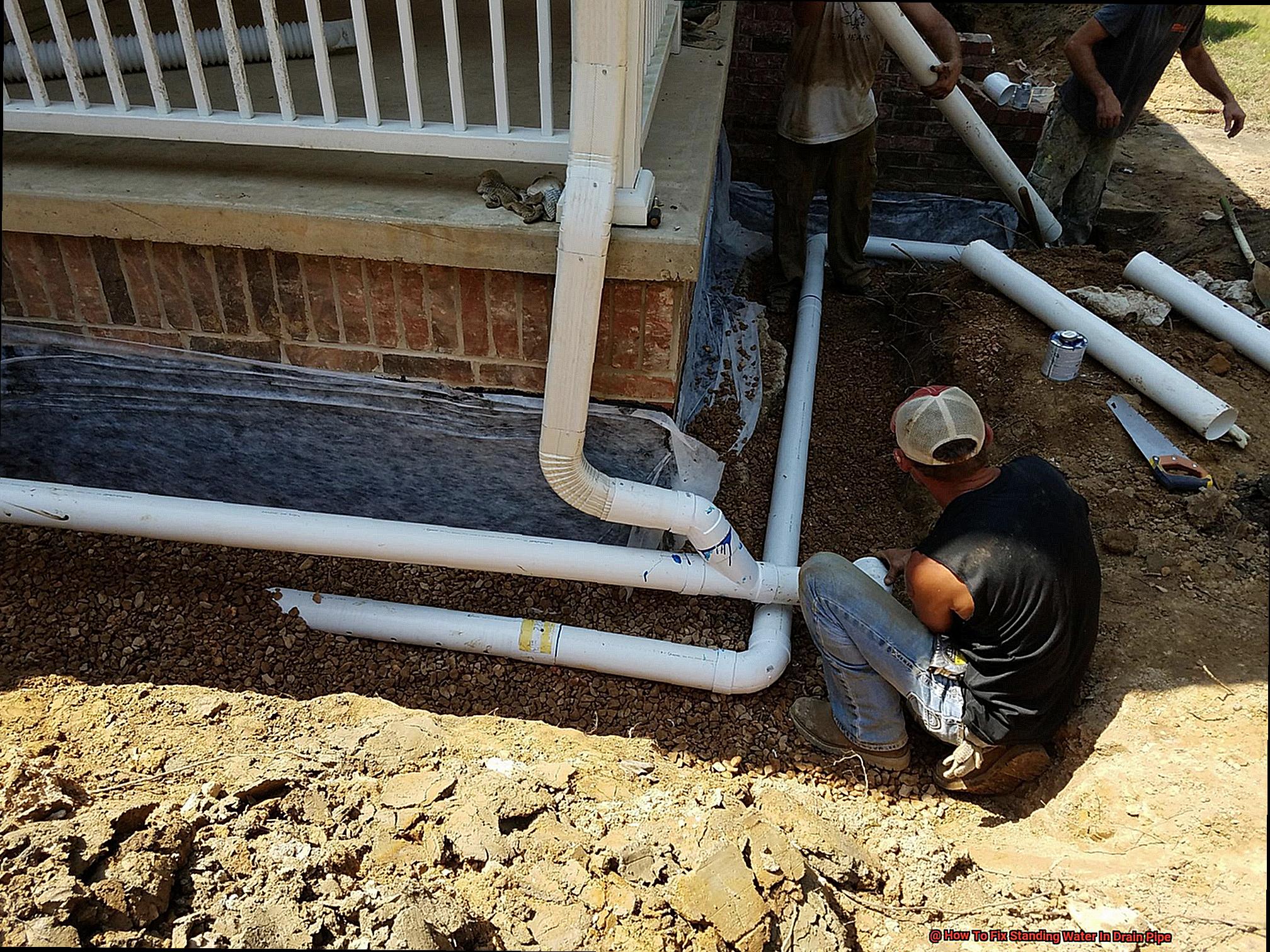
The solution may be as simple as using a plunger. A plunger is one of the most effective and widely used methods for fixing standing water in a drain pipe.
Whether you are dealing with a clogged sink or a slow-moving shower drain, a good plunger can be your saving grace. To use a plunger correctly, start by filling the sink or bathtub with enough water to cover the drain opening.
This will allow the water level to rise above the standing water. Next, place the plunger over the drain and press down firmly to create a seal.
It’s essential to choose a plunger with a flange or lip around the edge to ensure that you get the best seal possible. Now it’s time to get pumping.
Use short and forceful strokes to plunge up and down quickly. The goal is to create enough pressure in the pipe to force the standing water out and allow it to flow through.
Repeat this process several times, making sure to take breaks in between to allow the water to drain and refill as needed. It’s important to note that not all plungers are created equal.
Be sure to select a plunger that is appropriate for the size of your drain. A smaller sink plunger will not be effective on larger drains such as toilets or showers.
If you find that using a plunger does not resolve your issue or if you encounter other problems such as clogs or slow drains, it may be necessary to seek professional plumbing assistance.
Use a Drain Snake
This practical tool is flexible, long, and narrow and can help you get to the root of the problem by removing any blockages. To use a drain snake, you’ll need to insert it into the drain pipe until you reach the blockage.
Once there, gently rotate the snake to break up the obstruction and move it through the pipe. It’s crucial to be gentle with your movements so as not to damage your pipes.
But with a little patience and perseverance, those stagnant waters will soon be a thing of the past. There are different types of drain snakes available on the market.
Manual ones are affordable and straightforward, but they do require physical strength to operate. On the other hand, electric or battery-powered drain snakes are more expensive but easier to use and don’t require as much physical effort.
Before using a drain snake, it’s essential to take safety precautions. Plumbing can be messy work, so wearing gloves and eye protection is a must.
Clean the P-Trap
The P-trap is a curved pipe located under sinks and bathtubs, designed to trap water and prevent sewer gases from entering your home. However, over time, debris such as hair, soap, and food particles can accumulate in the trap and cause blockages.
To clean the P-trap, you’ll need a bucket, pliers, and a pipe wrench. Place the bucket underneath the trap to catch any water or debris that may spill out.
Loosen the slip nuts on either side of the P-trap using pliers or a pipe wrench if necessary. After removing the P-trap, give it a thorough cleaning using a brush or cloth.
For stubborn clogs, use a plumbing snake or wire hanger to remove them. Reattach the P-trap to the drain and tighten the slip nuts with pliers or a pipe wrench.
Call a Professional Plumber
These professionals have been trained and equipped to handle even the toughest plumbing issues, including stubborn clogs. Think of a licensed plumber as a superhero, ready to come to your rescue with their arsenal of tools and expertise.
They can diagnose the root cause of the problem quickly and provide an effective solution that will save you time and money in the long run. One technique that a licensed plumber may use is hydro jetting, which involves using high-pressure water to blast away any blockages in the drain pipe.
This process is like something out of a sci-fi movie, but it’s highly effective in clearing out even the most stubborn clogs. Another tool in a licensed plumber’s arsenal is video camera inspection.
This method involves inserting a small camera into the drain pipe to identify any underlying causes or damage that may be contributing to the standing water. It’s like detective work for your plumbing system.
While some may balk at the cost of hiring a licensed plumber, trying DIY solutions or relying on temporary fixes can end up costing you more time and money in the long run.
By calling in a professional, you can rest assured that the problem will be properly diagnosed and resolved, preventing future plumbing disasters.
Prevention Tips to Avoid Future Clogs and Blockages
Preventative measures can save you time, money, and frustration by avoiding future clogs and blockages. Here are five easy tips to keep your pipes running smoothly.
Use a drain strainer
A drain strainer is a cheap and effective tool that can prevent hair, food particles, and other debris from entering your drainpipe. This will allow you to remove the collected debris and prevent it from going down the drain.
Dispose of grease properly
Grease is one of the main culprits behind clogs in drain pipes. You should dispose of grease properly by collecting it in a separate container and then disposing of it in the trash.
Don’t pour hot water down the drain
Hot water can melt and soften the fats and grease in your drain pipe, leading to clogs. Instead, use cold water to flush down any excess dirt or debris.
Avoid using chemical drain cleaners
Chemical drain cleaners can damage your pipes and even cause them to corrode over time. Instead, opt for natural methods such as baking soda and vinegar to clear out any clogs.
Regularly clean your drains
Regular cleaning of your drains can help prevent any buildup of debris that can lead to clogs. You can use a mixture of baking soda and vinegar to clean your drains regularly.
It’s essential to be mindful of what goes down your drain to avoid potential blockages. Avoid pouring grease, oil, or other fatty substances down the sink or toilet as they can solidify and cause blockages. Similarly, avoid flushing anything other than toilet paper down the toilet as items like wipes, cotton buds, and feminine products can also cause blockages.
Regular maintenance is also crucial. Consider using a drain cleaner or snaking your pipes every few months to clear out any buildup. You can also try pouring boiling water down your drains once a week to help prevent blockages from forming.
Finally, be mindful of any warning signs that your pipes may be becoming blocked. Slow draining or gurgling sounds are early indicators that something may be blocking your pipes.
lWJ4bCisdww” >
Conclusion
In conclusion, standing water in your drain pipe can be a frustrating and unpleasant experience.
Not only does it cause foul odors, but it also slows down the drainage process. The root cause of this problem is often due to the buildup of smog, grease, soap scum, and food waste over time.
Minor leaks or cracks in the pipe can also be culprits of stagnant water. Fortunately, there are DIY solutions that you can try before calling in the professionals.
Plungers, boiling water, and baking soda and vinegar concoctions are simple yet effective ways to get rid of clogs. However, if these methods don’t work, it’s best to leave it to the experts who have access to drain snakes and cameras that can detect and remove stubborn blockages.
Prevention is key when it comes to avoiding future clogs and blockages. Use a drain strainer to prevent hair and food particles from getting into your pipes.
Dispose of grease properly by putting it in a separate container before throwing it away.
Avoid pouring hot water down the drain; instead, use chilled water.

